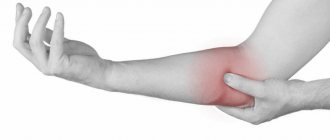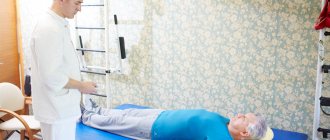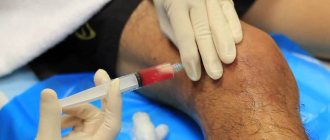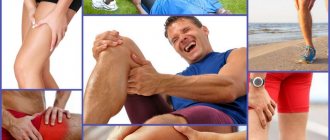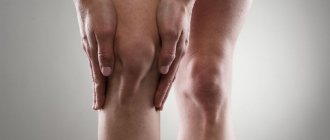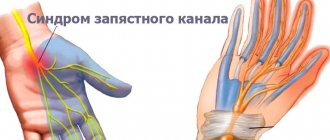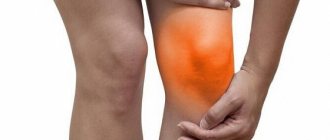Under the knees, in the very depths of the fossae, there are popliteal lymph nodes, covered by the surrounding great vessels. To palpate these nodes, the patient needs to lie on his stomach; at this time, the doctor holds the leg by the lower leg with his left hand, changing the flexion of the knee. In this case, you need to palpate the lymph nodes with your right hand; for this, the doctor palpates the popliteal fossa in different positions of the leg - elongated, bent at certain angles. This allows you to relax the leg, its muscle and tendon groups. If the lymph nodes are in normal condition, they cannot be palpated.
In healthy people, the lymph nodes behind the knee are of different sizes - it depends on their location. It is especially important to examine the lymph nodes over time if the doctor observes a joint disease of the knee. Enlarged lymph nodes under the knee at the back indicate the presence of a disease or the consequences of a previous illness.
To the touch in a fresh pathological process, the lymph nodes are soft and doughy. Tight junctions indicate tumors, sclerosis due to illness, including tuberculosis.
Meniscus injuries – rupture, cyst
A meniscus tear usually occurs at the peak of physical activity and is accompanied by acute pain. If the tear occurs in the back of the meniscus, the pain will radiate below the knee and back. Injuries of this kind occur in people who are actively involved in sports, usually at a professional level. A meniscus tear can be diagnosed using MRI; x-rays are useless in this case.
A meniscus cyst can appear with severe arthrosis of the knee joints and is not always associated with injury. Wear and tear of the joints and constant stress on them play a big role. A meniscus cyst can be diagnosed using MRI data.
Treatment in both cases should be carried out by an orthopedic traumatologist. As a rule, this is a surgical operation; for athletes, it can be meniscus replacement. More gentle methods in traumatology include injections of anti-inflammatory drugs into the joint and artificial synovial fluid.
We successfully use osteopathic methods in such patients at the stage of rehabilitation and recovery after injury. Soft fascial techniques allow you to achieve what is impossible to achieve with rough intervention - improve the functional state of the fascia, ligaments and tissues around the joint, and achieve proper distribution of the load on the joint.
The doctor will determine the reasons for the growth of glands under the knees
Leukemia
Painful enlargement of the lymph node under only one leg is lymphadenitis. The most common cause is bacteria that have entered the lymph node. Severe unilateral pain in the lymph node and general malaise should be the reason for visiting a therapist.
A common cause of lymphadenitis is local infection:
- colds, flu, sore throat;
- measles, rubella;
- hepatitis B and C;
- leukemia, lymphoma.
For any reason, popliteal lymphadenitis is accompanied by the same symptoms: fatigue, weakness, loss of appetite, frequent colds. The very signs of lymphadenopathy are the first symptoms of a complex pathology. Doctors usually associate enlarged lymph nodes in children with allergies and genetic underdevelopment of the immune system.
Anatomically, the lymph nodes under the knees are directly connected to the glands in the groin, helping them to resist infection in diseases of the feet and toes.
Baker's cyst
This is an outgrowth of the synovial membrane of the joint, filled with joint fluid. It occurs quite often, usually in women after 40 years of age. A Baker's cyst can cause aching pain under the knee and swelling in the popliteal fossa; with large cysts, the leg does not bend at the knee completely, and a “bump” can be felt behind the knee. To clarify the diagnosis, ultrasound of the knee and MRI are used.
Baker's cysts can be caused by inflammatory diseases, injuries, or arthrosis of the knee. Despite the fact that it is not a tumor, the cyst must be removed or punctured, since it can compress the vessels under the knee and cause complications such as thrombophlebitis and thromboembolism.
Treatment of inflammation of the lymph node under the knee joint
If inflammation of the lymph node is initiated by acute respiratory viral infections and colds, then you should take antiviral and symptomatic drugs, for example: Cytovir (for a virus), nose drops (Isofra), rub the chest (Bom-Benge), take cough syrup (Ascoril), strengthen your diet vitamin C (greens, beets, cabbage, fruits). After recovery, hardening is recommended to strengthen the immune system.
As has already been noted, the lymphatic system performs a transport function, which provides the body with immune cells, but tumor cells are also carried along the lymphatic ducts and form directly in them. Tumors of the lymphatic system are called lymphomas; they are dangerous due to uncontrolled division leading to death. If the lymph node is inflamed due to a tumor, then the patient should urgently undergo treatment with an oncologist and strictly follow all prescribed recommendations.
Syphilitic inflammation of the popliteal lymph node is treated with penicillin antibiotics. Anti-syphilis tablets do not have the desired effect due to low bioavailability, so only injections are used. For persons with allergies to penicillins, antibiotics are replaced with macrolides, tetracyclines or chloramphenicol. After the course of treatment, the patient should undergo a control blood test to detect triponema after 6 months. Inflammation of the lymph node due to tuberculosis is eliminated by comprehensive treatment of the cause of the disease. For this purpose, a 3-, 4-, 5-component treatment regimen and chemotherapy are successfully used. Three-component scheme (classical): Isoniazid Streptocide PAS Four-component scheme: Phtivazid Kanamycin Rifabutin Ethionamide Five-component scheme: Bedaquiline Pretomanid Moxifloxacin Linezolid Pyrazinamide Sanatorium-resort treatment, taking balham. The cause of inflammation due to measles is eliminated by taking it by increasing the body's resistance to the virus. This is achieved by taking leukinferon, cytokines, anti-measles alpha globulin and antihistamines. Antibiotics are also “actively involved” in healing, such as clarithromycin and azithromycin. When coughing occurs, Ambroxol, Erespal, and Ascoril are prescribed.
If the lymph node is inflamed due to a meniscus cyst, then surgery is prescribed to remove the growth, and then massage, UHF, phonopheresis with hydrocortisone, and swimming are prescribed. A honey compress and rubbing with tincture of wormwood and garlic perfectly complement the treatment. A burdock compress works well for pain relief after surgery. Its roots can be stocked during the period of its active growth, and the leaves are collected in September and the roots in September. A sufficient number of roots will provide the patient with year-round assistance in relieving pain. Wash the fresh roots and place them whole in a jar and then in the freezer. Whatever causes the inflammation of the lymph node under the knee, it needs to be treated. Self-treatment is equivalent to shooting sparrows from a cannon. This problem should only be treated in a hospital.
Diseases of the soft tissues of the joint, tendons
The knee joint has 6 ligaments and up to 10 bursae (depending on individual characteristics), a thin capsule surrounding the joint. In untrained people, even minor long-term exercise can cause tendonitis (inflammation of the tendon) or bursitis (inflammation of the bursa). With awkward movement, the joint capsule can be pinched between the ligaments. All this causes pain, which is often nagging in nature and is often localized in the back of the knee and under it.
Diagnosis of knee ligament diseases necessarily includes MRI. Treatment uses cold, rest and anti-inflammatory drugs. We perform osteopathic manipulations on our patients that allow us to release the pinched joint capsule or relieve tension from the ligaments and fascia of the knee. Pain under the knee goes away several times faster after complex treatment.
Features of therapy
Lymphadenopathy cannot be treated, as it is not an independent disease. In case of inflammation of the lymph nodes, it is necessary to determine the cause and causative agent of the disease, and then select complex therapy. After eliminating the cause, the inflammatory process goes away.
If lymph flow is disrupted, it is necessary to exclude the malignant nature of the disorder, and then adjust your lifestyle. This pathology is treated with lymphatic drainage massage, therapeutic exercises, and drugs to improve lymph flow.
In general, therapy depends on the cause. If a person is diagnosed with tuberculosis, which leads to enlarged lymph nodes, a course of long-term antibacterial therapy is necessary. In treatment, 5 potent drugs are used at once for six months or more. If damage to the lymph nodes occurs against the background of sexually transmitted diseases, complex antibacterial therapy is prescribed. For syphilis, antibiotics from the penicillin group are taken.
For furunculosis of the lower extremities, either conservative treatment is prescribed using antibacterial ointments, or surgical removal of the boil is practiced.
Infections of the popliteal fossa, enlarged lymph nodes
The soft tissues of the popliteal region can become inflamed after undetected injuries, cuts, or punctures of the skin. Severe pain, swelling and temperature are caused by an abscess of the popliteal fossa, in which pus accumulates under the skin. Treatment is only surgical.
Enlarged lymph nodes under the knee can also be accompanied by discomfort and swelling. Since lymph from the lower part of the leg flows into the popliteal lymph nodes, their increase indicates an inflammatory process somewhere below. It is necessary to check the condition of the veins, the presence of ulcers on the lower leg or foot, suppuration, cuts and deep punctures, which can cause infection and suppuration.
Diagnostics
If discomfort occurs, you should go to the doctor. First of all, you need to visit a rheumatologist and traumatologist to rule out pathologies of joints, ligaments and tendons. This is due to the fact that injuries and bruises of the popliteal fossa have the same symptoms as lymphadenopathy.
Ultrasound is performed to determine the causes of inflammation and choose the right direction of therapy.
To diagnose the condition of the lymph nodes, the following examinations are necessary:
- general and biochemical blood tests;
- X-ray of the knee;
- Ultrasound of lymph nodes.
General and biochemical blood tests can identify inflammatory processes. These are the first tests that the patient must undergo. Radiography allows us to exclude pathologies of bone tissue and joints, which can lead to enlargement and inflammation of the lymph nodes. Ultrasound allows you to visualize the condition of the popliteal lymph nodes, but in some cases this study is not enough, so MRI is additionally prescribed.
To identify hidden infections that can lead to inflammation of the lymph nodes, it is necessary to take a PCR test.
Diseases of the nerves and blood vessels of the popliteal fossa
There are three large structures running beneath the knee: the tibial nerve, the popliteal artery, and the popliteal vein. Acute pain radiating to the lower part of the leg accompanies damage to the tibial nerve, for example, due to injury and pinching. A throbbing, aching pain under the knee is characteristic of a popliteal artery aneurysm. Popliteal vein thrombosis is not common and may be a complication of Baker's cyst. The pain is aching, not severe, and often the disease can only be recognized at a late stage. Ultrasound with Doppler is of decisive importance, which allows identifying a blood clot in the popliteal vein.
Alarming signs in the condition of the lymph nodes
As a rule, the glands under the knees enlarge with the onset of the disease. There is also the opposite situation - the pathological state of the nodes, when in a completely healthy body they remain large and hard, like beans, but with the onset of an inflammatory disease in the body they soften and shrink. This is a pathology, but it is considered normal if this situation occurs repeatedly in a child.
It's worth considering if:
- the nodes have been enlarged for several weeks;
- the nodes are enlarged only in one popliteal fossa;
- along with them, other lymph nodes are enlarged;
- it is difficult to palpate the edges of the gland;
- the skin over the gland does not move.
Often the skin changes color, becomes hot, and skin ulceration may appear. Sometimes the symptom of the disease is lymphadenopathy alone, without other symptoms. These are situations where you need to take the right step - go to the clinic.
How to strengthen your knees
Knee diseases are “getting younger”: if previously they affected people aged 55–60 years, now problems with the musculoskeletal system are found among young Russians aged about 40 years. This is due, among other things, to an inactive lifestyle, improper loads, and sports that people do without the involvement of specialists or not at all. Excess weight causes great harm to the joint.
Prevention is the best way to prolong the health of your knee joints, which includes:
- body weight control,
- a balanced, proper diet rich in healthy vitamins and minerals,
- moderate therapeutic exercises, which make joints more mobile and also strengthen muscles.
The complex is suitable for people accustomed to any level of physical activity. The exercises do not require preparation, but we recommend that you first consult with an osteopath or your doctor. There may be individual contraindications - for example, for illnesses and injuries.
Exercise 1. Position - lying flat on your stomach, arms extended along the body. Bend your leg at the knee joint at a right angle, hold it in this position for 5–8 minutes, then straighten it. Alternate your legs. The number of approaches for each limb is 8–10 times.
Exercise 2. Position - sitting on a chair with legs bent at right angles. Straighten one leg at the knee and lift it parallel to the ground (or as far as you can), hold for about 8 seconds, return to the starting position. Repeat the same with the second leg. Do the exercise 10 times on each leg.
Exercise 3. Position - standing, feet shoulder-width apart, rivers lying on the back of a chair, the chair with its back turned towards you. Raise your leg, bending the knee joint, to a right angle, and immediately release. Do 12–15 reps on each leg, preferably three reps.
Exercise 4. The same position as in the previous task, only the leg is not pulled back, but raised in front of you with a delay of 12–15 seconds. Do not bend at the waist, do not abduct your hips. Do 3 reps on each leg, 2 reps.
Exercise 5. For this exercise you need a low elevation, for example, a step, a stack of books, a low bench. The exercise simulates climbing stairs: lift one leg to a height, pull up the other so that both legs are on top, and descend in the same way. Take your time. For each leg, repeat the action 20 times.
Exercise 6. For this task you will need a training roller, but a blanket rolled into a roller will also work. Sit on the floor and place your leg on the bolster so that it is exactly under the knee joint. Slowly straighten your knee so that it forms a straight line from your hip. Return to original position. Repeat 10 times, 5 passes.
Exercise 7. Position - pressing your back against the wall. Slowly bend your knees until you are in a half-squat position, but keep your shoulder blades pressed against the wall. Maintain a static pose for 30 seconds. Repeat three times.
Exercise 8. For this task you need a ball of small diameter. Sit on the floor, place a ball under your knee joint and bend your leg, pulling your heel toward your buttock with your hand. Hold the limb in this position for about half a minute, do 3-4 times on each leg.
Factors that lead to pathology
Infections
As is known, inflammation of the lymph nodes is a consequence of another disease, and these root causes can be divided into two groups: infectious diseases and tumor pathology.
The first group includes diseases caused by staphylococcal and streptococcal infections, salmonellosis, syphilis, various viruses and parasites, in which case inflammation can be observed in several areas. This group also includes HIV infection, which is always associated with a low level of immunity, and the lymph nodes, as organs of the immune system, as they say, take the blow. A similar phenomenon is observed with viral hepatitis, measles, tuberculosis, fungal and chlamydial infections, and even as a result of infection through cat scratches. Inflammation can also be caused by any type of malignant tumor.
Immune disease
Quite rare causes of this problem are also known, and here the first place is occupied by immune diseases, among which rheumatoid arthritis is the leader. The appearance of a lump under the knee joint in this case may indicate that arthritis is progressing, and the immune system is having difficulty coping with the inflammatory process in the joints. Taking certain types of drugs, in particular those whose action is aimed at relieving cramps and spasms in the muscles, can also be a kind of impetus for the formation of nodes.
Sometimes inflammation occurs after a procedure such as silicone implantation. It should be noted here that this material is used not only for breast augmentation, but also as a retainer in bone prostheses. The immune system reacts to its presence with an inflammatory process, and such manifestations account for 15% of the total number of all cases of use of the material. However, it should be taken into account that almost any disease or excessive stress can lead to the appearance of a lump, and its development depends on the state of the immune system.
There are signs by which the nature of neoplasms is determined. So, if the increase affected only one group of nodes, pain appears only upon palpation, and the neoplasms themselves are soft and mobile and did not lead to changes in the skin and blood vessels, then we can assume the origin of the problem is infectious. In this case, an increase in temperature is often observed. The situation is more serious if the neoplasms are elastic and completely painless, since in this case a tumor is most often diagnosed. If the nodes are hard to the touch, then, as a rule, we are talking about the development of a malignant formation of lymphoid tissue. In this case, rapid damage to organs and systems occurs, and the disease is accompanied by excessive sweating and sudden weight loss.
As practice shows, most of the reasons for enlarged popliteal lymph nodes lie in local infection. In this case, the size of a neoplasm of up to 1.5 cm is considered normal, but if it has not decreased within a month, then this serves as a reason for a detailed examination and a biopsy may be required. Age should also be taken into account: the older it is, the higher the risk of developing a malignant tumor. In any case, you need to know: if the lymph node in the area under the knee is inflamed, there is an infection in the body, and it should be eliminated. This can be done by contacting a doctor for further examination and treatment.
Benefits of osteopathy in treating knee pain
- Gentle techniques that do not cause increased pain.
- In many cases, osteopathy helps to cope with the disease without surgery.
- Only an osteopath in case of leg diseases will help restore the balance of the body and remove secondary dysfunctions.
- After surgery, osteopathy helps speed up the recovery process.
- We conduct a full examination of all patients, regardless of symptoms, as well as complete correction of all significant dysfunctions of the body, since everything in our body is interconnected!
Classification
When determining the forms of lymphadenopathy, the location of enlarged lymph nodes is primarily taken into account. Lymphoid tissue is the main protective barrier against the spread of infectious pathogens and tumor cells. Therefore, the location of altered lymphatic formations facilitates the diagnosis of the disease that caused the lymphadenopathic reaction. Depending on the localization of the process, the following are distinguished:
- Enlargement of the submandibular lymph nodes
. Characteristic of pathological processes in the head and neck area - diseases of the eyes, ENT organs and paranasal sinuses, skin damage. Submandibular lymphadenopathy often signals dental problems and chronic tonsillitis. - Enlarged cervical lymph nodes
. Usually observed with respiratory infections, oral pathology, infectious mononucleosis, late stages of tuberculosis. Cervical nodes can be affected by lymphomas, lymphogranulomatosis, metastasis of thyroid cancer, lung cancer. - Enlarged supraclavicular lymph nodes
. Most often due to tumor causes. Detection of an enlarged node on the right is pathognomonic for cancer of the esophagus and lungs. The left lymph node is affected by malignant processes in the abdominal cavity, pelvis, and retroperitoneal space. - Enlarged axillary lymph nodes
. Inflammatory lesions are possible in the presence of wound infections, cat scratch disease, and brucellosis. Damage to the nodes of the axillary group is typical for breast cancer, melanoma of the upper extremities, and the installation of silicone breast implants. - Enlarged inguinal lymph nodes
. As a rule, nodes in the groin react to the development of syphilis, gonorrhea, chancroid, and other genital infections. Inguinal lymphadenopathy is also a sign of malignant lesions of the pelvic organs, lymphoma, and bubonic plague.
Somewhat less frequently, lymph nodes of other groups are involved in the process - submental, cubital (in the area of the elbow), parotid, occipital, jugular. During a routine instrumental examination, an increase in internal lymph nodes can be determined - intrathoracic (mediastinal), bronchopulmonary, para-aortic, splenic, mesenteric, retroperitoneal.
In the diagnostic plan, it is important to take into account other criteria for the classification of lymphadenopathy - the characteristics of altered lymphoid formations, the extent of the lesion. This approach allows us to assume the type of pathological process occurring in the involved nodes and the body as a whole. Important criteria for the classification of enlarged lymph nodes are:
- Dimensions
. With I degree lymphadenopathy, the diameter of the affected formations is 0.5-1.4 cm, with II degree - 1.5-2.4 cm, and with III degree - 2.5 cm or more. A significant and prolonged increase in the size of lymph nodes is more typical for malignant processes. - Soreness
. Intense pain is often caused by inflammation of the lymph nodes, especially acute purulent lymphadenitis. Formations that have undergone malignant degeneration are often painless, except in cases of hemorrhage into the necrotic center. - Density
_ Enlarged, inflamed lymph nodes are usually soft; when they suppurate, fluctuation (fluctuation of fluid) is felt during palpation. The stony consistency of the formations is typical for the metastatic process, and tight elasticity is typical for lymphomas. - Communication with each other
. A pathological formation of lymph nodes that can be felt as a single unit and move together is called a conglomerate. Lymph nodes fused together are detected in tuberculosis, sarcoidosis, lymphogranuloma venereum, lymphomas and metastasis. - Quantity
. It can affect either one or two or several nodes in one zone. In the first case, they talk about single enlarged nodes, in the second - about local lymphadenopathy. The more active the process, the more formations are affected, however, with metastasis, one large node is often detected. - Prevalence
. With local lymphadenopathy, single nodes are identified in one area, with regional lymphadenopathy - several formations in 1-2 adjacent zones. A generalized (widespread) process is characterized by damage to lymphatic structures in three or more areas.
Taking into account the pathogenesis, enlargement of lymph nodes can be primary (systemic), secondary (reactive) and inflammatory. Primary polyadenopathies develop with systemic malignancy of lymphoid tissue (leukemia, lymphogranulomatosis, non-Hodgkin's lymphoma) and benign processes (sinus histiocytosis). Reactive lesions are a response to another pathology (infection, immune disease, proliferation of tumor cells, metabolic disorders). Inflammation (lymphadenitis) occurs when infectious agents multiply in the tissue of the node.
